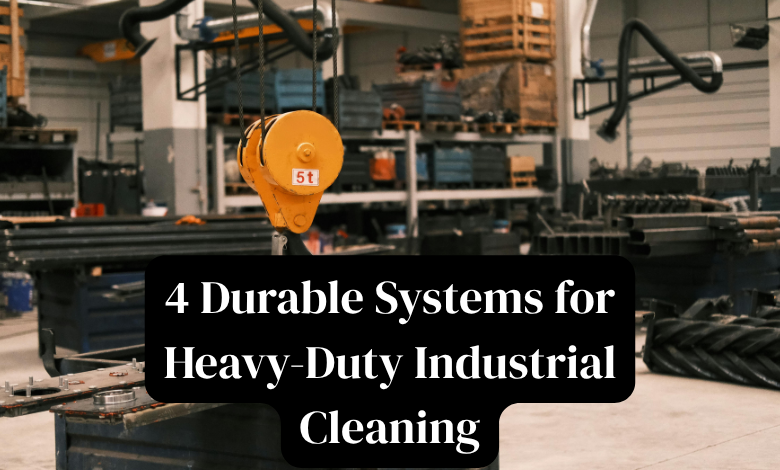4 Durable Systems for Heavy-Duty Industrial Cleaning

In demanding industrial settings, cleanliness is not just about appearances—it’s about safety, efficiency, and operational integrity. Standard cleaning methods often fall short when faced with hardened grease, chemical residues, rust, and other stubborn contaminants common in manufacturing plants, construction sites, and municipal infrastructure. This is where heavy-duty cleaning systems come into play. Understanding the right system for the job can significantly improve outcomes, extend the life of your equipment, and create a safer working environment.
This guide explores four durable and effective systems designed to handle the most challenging cleaning tasks, helping you determine which solution best fits your operational needs.
1. High-Pressure Water Jetting
High-pressure water jetting is a powerful and versatile method that uses water propelled at extreme velocities to clean surfaces and remove tough materials. This technique can slice through grease, strip paint, and clear blockages without using harsh chemicals, making it an environmentally friendly option. Systems can range from 10,000 to over 40,000 PSI, and their effectiveness depends on matching the right pressure and flow rate to the specific application.
For instance, removing caked-on mud from construction equipment might only require moderate pressure, while cutting through concrete or descaling industrial boilers demands ultra-high-pressure capabilities. The durability of these systems lies in their robust components, such as high-strength pumps and wear-resistant nozzles, which are engineered to withstand the intense forces involved. Modern systems also incorporate advanced safety features, including automated pressure controls and emergency shut-offs, to protect operators. When considering this method, it’s crucial to evaluate the material being cleaned to avoid surface damage. Proper training is also essential to ensure safe and effective operation, as the power of high pressure water jetting can pose significant risks if not handled correctly.
2. Abrasive Blasting
Often known as sandblasting, abrasive blasting is a technique that involves forcibly propelling a stream of abrasive material against a surface under high pressure. This method is highly effective for surface preparation, such as removing rust, old paint, and other coatings from metal before repainting or recoating. The choice of abrasive media—which can range from sand and glass beads to steel grit and even dry ice—is critical. Each material offers a different level of abrasiveness and is suited for different surfaces. For example, softer media like walnut shells are used for delicate cleaning tasks, while harder materials like steel grit are reserved for aggressive rust removal.
The durability of abrasive blasting systems comes from their heavy-duty construction, designed to handle the continuous flow of abrasive materials without rapid wear. Key components include a pressurized vessel, a blasting hose, and a nozzle, all of which must be regularly inspected and maintained to ensure longevity and safety. One major advantage is its speed and efficiency in preparing large surfaces. However, it generates significant dust and debris, requiring proper containment and respiratory protection for operators.
3. Ultrasonic Cleaning
Ultrasonic cleaning offers a high-tech solution for cleaning intricate and complex parts that are difficult to reach with other methods. This process uses high-frequency sound waves (typically 20–40 kHz) transmitted through a liquid solvent to create millions of microscopic bubbles. This phenomenon, called cavitation, causes the bubbles to implode with immense force, dislodging contaminants from every nook and cranny of the submerged object.
This method is ideal for cleaning everything from delicate medical instruments and electronic components to robust automotive parts like fuel injectors and carburetors. The systems consist of a stainless steel tank, ultrasonic transducers, and a generator. Their durability is a result of high-quality construction and the non-contact nature of the cleaning process, which minimizes mechanical wear. The main benefit is its ability to deliver a microscopic level of cleanliness without damaging the object. While the initial investment can be higher than other systems, the precision, consistency, and reduced labor costs often provide a strong return on investment for specialized applications.
4. Dry Ice Blasting
Dry ice blasting is an innovative and non-abrasive cleaning method that uses solid carbon dioxide (CO2) pellets as the blasting medium. These pellets are accelerated in a jet of compressed air and sublimate—turn from a solid directly into a gas—upon impact with the surface. The rapid thermal shock and expansion of the gas lift contaminants off the underlying material without causing any abrasion or creating secondary waste.
This system is particularly useful in industries where water, chemicals, or abrasive media are prohibited, such as food processing, aerospace, and electronics manufacturing. It effectively removes grease, oil, mold, and production residues from machinery and equipment. The equipment itself is built to handle the extremely low temperatures of dry ice (-109.3°F or -78.5°C) and includes a hopper, a feeding system, and a specialized nozzle. Since it leaves no residue, the cleanup time is virtually eliminated. This makes dry ice blasting one of the fastest and cleanest heavy-duty methods available, though the cost of dry ice and specialized equipment can be a consideration.



